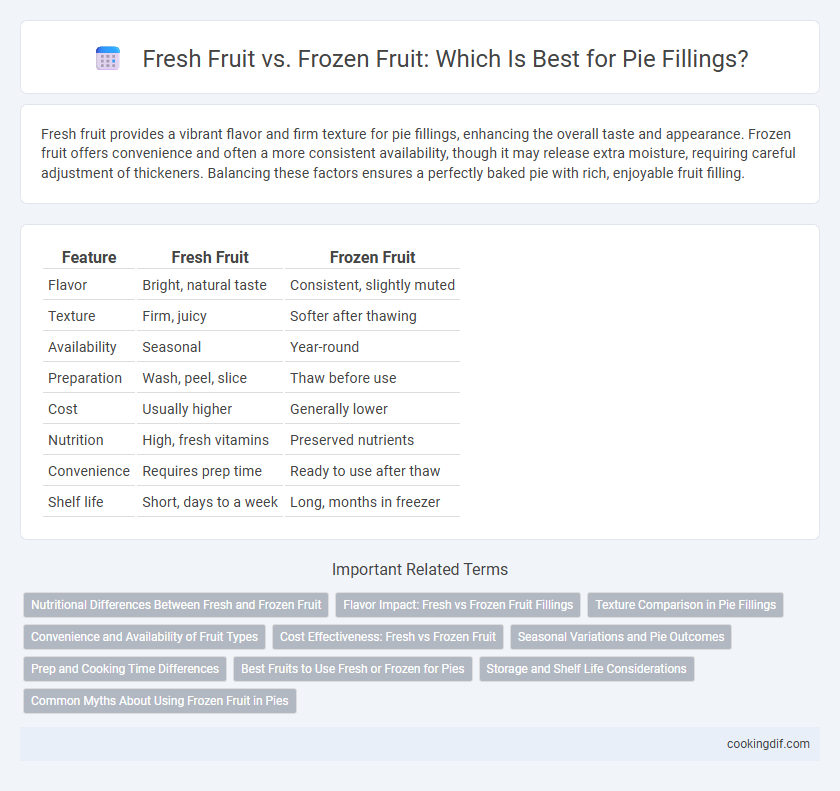Fresh fruit provides a vibrant flavor and firm texture for pie fillings, enhancing the overall taste and appearance. Frozen fruit offers convenience and often a more consistent availability, though it may release extra moisture, requiring careful adjustment of thickeners. Balancing these factors ensures a perfectly baked pie with rich, enjoyable fruit filling.
Table of Comparison
| Feature | Fresh Fruit | Frozen Fruit |
|---|---|---|
| Flavor | Bright, natural taste | Consistent, slightly muted |
| Texture | Firm, juicy | Softer after thawing |
| Availability | Seasonal | Year-round |
| Preparation | Wash, peel, slice | Thaw before use |
| Cost | Usually higher | Generally lower |
| Nutrition | High, fresh vitamins | Preserved nutrients |
| Convenience | Requires prep time | Ready to use after thaw |
| Shelf life | Short, days to a week | Long, months in freezer |
Nutritional Differences Between Fresh and Frozen Fruit
Frozen fruit retains most vitamins and minerals found in fresh fruit due to rapid freezing techniques that preserve nutrient content, especially vitamin C and antioxidants. Some water-soluble nutrients may degrade slightly in fresh fruit if stored for long periods, while frozen fruit can maintain consistent nutrient levels throughout the year. Choosing frozen fruit for pie filling ensures a rich supply of essential nutrients with minimal loss, enhancing both flavor and health benefits.
Flavor Impact: Fresh vs Frozen Fruit Fillings
Fresh fruit fillings deliver vibrant, natural flavors with a juicy texture that enhances the pie's overall taste, while frozen fruit fillings can sometimes lose their bright taste and develop a watered-down texture due to thawing. The freezing process often causes cell walls in the fruit to break down, resulting in a softer filling that may release excess moisture during baking. Choosing fresh fruit ensures maximum flavor clarity and firmness, crucial for pies where texture and taste are paramount.
Texture Comparison in Pie Fillings
Fresh fruit in pie fillings offers a naturally firm texture that holds shape better during baking, resulting in a more distinct, satisfying bite. Frozen fruit often releases more moisture as it thaws, leading to a softer, sometimes mushier filling that can compromise the pie's structural integrity. The difference in water content between fresh and frozen fruit significantly affects the final texture and mouthfeel of pie fillings.
Convenience and Availability of Fruit Types
Frozen fruit offers extended availability year-round, ensuring convenient access to a wide variety of seasonal fruits regardless of local harvest times. Fresh fruit requires timely selection and preparation, often limited by seasonal and regional availability that can impact the choice of pie fillings. The convenience of frozen fruit includes pre-washed, pre-cut options, reducing preparation time while fresh fruit may require more handling but can deliver optimal flavor and texture when perfectly ripe.
Cost Effectiveness: Fresh vs Frozen Fruit
Frozen fruit is generally more cost-effective than fresh fruit for pie fillings due to lower prices and reduced waste from spoilage. Bulk purchasing and year-round availability of frozen fruit help maintain consistent costs, especially when seasonal fresh fruit prices spike. Using frozen fruit also minimizes the risk of revenue loss linked to unsold, perishable inventory.
Seasonal Variations and Pie Outcomes
Fresh fruit fillings in pies offer peak flavor and texture during their natural seasons, resulting in vibrant, juicy outcomes with optimal sweetness and firmness. Frozen fruit provides consistent availability year-round, though it often releases more water during baking, leading to softer, sometimes mushier pie textures. Choosing fresh or frozen fruit affects filling thickness, sweetness levels, and overall pie quality, depending on seasonal fruit ripeness and storage methods.
Prep and Cooking Time Differences
Fresh fruit requires minimal preparation time since it can be sliced or peeled directly before filling, while frozen fruit often needs thawing to remove excess moisture. During cooking, fresh fruit tends to release more natural juices quickly, potentially reducing baking time, whereas frozen fruit's higher water content can extend cooking due to the need for evaporation. The difference in moisture levels between fresh and frozen fruit directly impacts both preparation and baking durations in pie making.
Best Fruits to Use Fresh or Frozen for Pies
Best fruits for fresh pie fillings include apples, peaches, and berries, prized for their natural sweetness and firm texture that hold up well during baking. Frozen fruits such as cherries, blueberries, and blackberries are excellent for pies when fresh options are out of season, maintaining flavor and nutrients through flash-freezing. Using fresh fruit yields a juicier texture, while frozen fruit provides convenience and consistent quality, enhancing the pie's overall taste.
Storage and Shelf Life Considerations
Fresh fruit offers vibrant flavor and texture ideal for pie fillings but has a limited shelf life, typically lasting only a few days to a week when refrigerated. Frozen fruit extends storage capabilities, preserving quality for several months without significant nutrient loss, making it a convenient option for year-round baking. Proper thawing and minimal moisture control are essential to maintain texture and prevent sogginess in pie fillings made from frozen fruit.
Common Myths About Using Frozen Fruit in Pies
Frozen fruit often gets an undeserved reputation for being watery or lacking flavor when used as pie filling, but modern freezing techniques preserve much of the fruit's natural texture and taste. Common myths suggest frozen fruit makes pies soggy, yet properly thawed and drained frozen fruit can create a filling with just as much juiciness and sweetness as fresh fruit. Studies and baking experts confirm that choosing frozen fruit can provide a convenient, cost-effective, and year-round alternative to fresh fruit without compromising pie quality.
Fresh fruit vs Frozen fruit for filling Infographic

 cookingdif.com
cookingdif.com